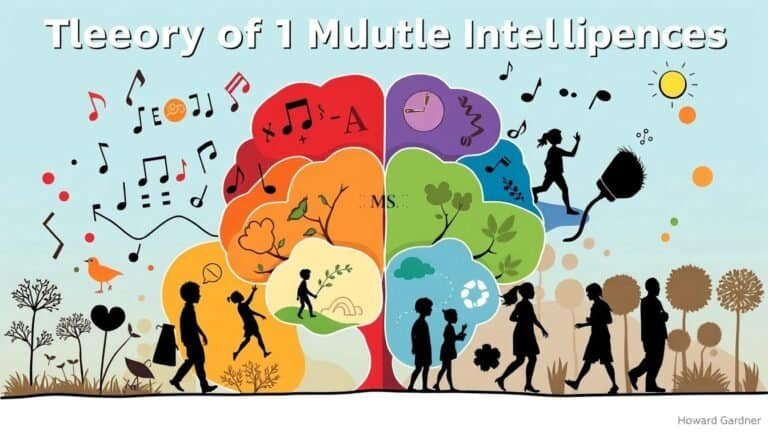Understanding Cognitive Appraisal Theory of Emotion
Have you ever thought about why a simple setback can make people feel different things? This question is key to the Cognitive Appraisal Theory of Emotion. It was first brought up by psychologist Richard Lazarus. He said our feelings come not just from what happens, but how we think about it.
This theory shows how our thoughts shape our feelings. We’ll look into how it compares with other big theories like James-Lange, Cannon-Bard, and Schachter-Singer.
The Cognitive Appraisal Theory talks about two main steps: primary and secondary appraisal. Primary appraisal checks if a situation is a threat. Secondary appraisal looks at our resources to deal with it. This back-and-forth between thinking and feeling helps us understand our emotional journeys better.
Let’s see how our thoughts and culture shape our feelings in the next parts.
Key Takeaways
- The Cognitive Appraisal Theory of Emotion emphasizes interpretation over stimulus.
- Richard Lazarus is a key figure in developing the cognitive appraisal theory.
- Primary and secondary appraisals are crucial for understanding emotional reactions.
- How we see situations can lead to different feelings.
- Cognitive biases greatly affect how we see our feelings.
- Culture greatly influences how we appraise emotions.
Introduction to Emotion Theories
Understanding human emotions involves looking at different theories. These theories look at emotions from physical, brain, and thought aspects. Six main theories help us explore this:
- Evolutionary Theory
- James-Lange Theory
- Cannon-Bard Theory
- Schachter-Singer Theory
- Cognitive Appraisal Theory
- Facial-Feedback Theory
The James-Lange theory says emotions come from how our body reacts to things. The Cannon-Bard theory believes emotions and physical reactions happen at the same time. They don’t cause each other. The Schachter-Singer theory, or the two-factor theory, says our body gets excited first, then we think about what we’re feeling.
Cognitive emotion theory looks at how we think to figure out our feelings. It says our feelings come from how we see our body’s state. The facial-feedback theory connects our face’s expressions to our feelings. It shows how our body language affects our emotions.
Studies show these theories help us understand how emotions affect our actions and choices. Famous psychologists like Frijda and Lazarus have studied this. These theories show how thinking affects our feelings.
| Theory | Main Concept | Key Insight |
|---|---|---|
| Evolutionary Theory | Emotions evolved to enhance survival | Emotions help us adapt to our environment |
| James-Lange Theory | Emotions result from physiological reactions | Feeling arises from bodily responses |
| Cannon-Bard Theory | Physical reactions and emotions are simultaneous | Both occur independently of each other |
| Schachter-Singer Theory | Physiological arousal followed by cognitive labeling | Emotion is derived from interpreting arousal |
| Cognitive Appraisal Theory | Emotions stem from cognitive evaluations | Thoughts shape the emotional experience |
| Facial-Feedback Theory | Facial expressions influence emotional experience | Body language can affect how we feel |
These theories give insights to researchers and practitioners on handling emotions in different situations.
Defining Cognitive Appraisal Theory
Cognitive appraisal theory looks at how we evaluate our feelings when we face different situations. It says that our emotions come from how we see and judge these situations. Richard Lazarus introduced this idea, changing how we view emotions by focusing on our thoughts.
This theory looks at the history of how we think about emotions. It shows how our thoughts affect how we feel.
Historical Background and Key Contributors
In the 1960s, cognitive appraisal theory started to take shape. Richard Lazarus was a key figure, moving from behaviorism to a focus on thinking. His book from 1966, “Psychological Stress and Coping Process,” explained how our thoughts shape our feelings.
Later, researchers like Scherer built on this idea. They showed how we go through a process to understand and feel emotions. Scherer’s model talks about different parts of this process, like how we handle situations and our coping abilities.
Understanding the Process of Emotional Appraisal
Emotional appraisal happens in two steps. First, we decide if an event is good, bad, or doesn’t matter to us. Then, we look at how we can deal with it. This helps us understand and react to our feelings.
Lazarus stressed the role of these evaluations. He showed how seeing things differently can change how we feel. This theory looks at how our thoughts influence not just our feelings, but also our choices and how we cope.
The Cognitive Appraisal Theory of Emotion
The cognitive appraisal theory of emotion helps us understand how we feel based on what we think about things. It says our feelings come from how we see events, not just the events themselves. Our feelings can change because of our past, culture, or how we feel inside. This means different people can feel different things in the same situation.
Studies show that thinking is key to emotions. For example, Frijda, Kuipers, and ter Schure (1989) found a strong link between how we feel and what we think. Smith (1989) showed how our thoughts affect our feelings and body reactions. Kuppens et al. (2007) looked at how people differ in how they think about anger, showing the complex nature of emotions.
Richard Lazarus was a big name in this area. He talked about two main ways we think about events: primary and secondary appraisals. Primary appraisal looks at how important and emotional an event is. Secondary appraisal checks if we can handle the event’s outcomes. This idea helps us better understand our feelings and how to deal with them.
The structural model of appraisal explains how we link our thoughts to feelings. It says the primary appraisal looks at if an event matters and fits with our feelings. This shows that how we see the world affects our feelings and how we react.
Key Dimensions of Cognitive Appraisal
Cognitive appraisal theory shows how we judge situations to feel emotions. It looks at internal and external appraisals. These help us understand how we feel and what we think is right or wrong.
Types of Appraisals: Internal vs. External
Internal appraisals are about what we believe and feel inside. They tell us how we see ourselves and our experiences. On the other hand, external appraisals look at the world around us and how it affects us.
For example, seeing success as personal or just getting praise can change how we feel. This shows how different people can react the same way but feel differently.
Dimensions of Morality in Emotional Experiences
Morality and feelings work together in cognitive appraisal. When we judge a situation as right or wrong, it changes how we feel. Feeling guilty or ashamed can happen when we think our actions are wrong.
A study in 1997 by Scherer found that joy is similar across cultures. But feelings like guilt and anger can vary a lot. These differences depend on how we see morality in our feelings.
| Cognitive Appraisal Dimension | Description |
|---|---|
| Novelty | Assessment of how new or different an event is. |
| Unpleasantness | Evaluation of how negative or distressing the event feels. |
| Goal Obstruction | Perception of whether an event hinders personal goals. |
| Unfairness | Determination of whether an event is perceived as unjust. |
| External Causation | Recognition of external factors contributing to the event. |
| Coping Ability | Belief in one’s ability to handle and resolve the situation. |
| Immorality | Evaluation of the moral implications associated with an event. |
| Self-Consistency | How well the event aligns with one’s self-image and values. |
Two Views on the Relationship Between Appraisal and Emotion
The relationship between how we think and feel is complex. It shows two main views on how thoughts and feelings connect. These views help us understand how our thoughts lead to feelings and vice versa. They highlight how our thoughts and feelings work together during different experiences.
Cognitive Appraisal Causing Emotions
This view says that our thoughts deeply affect our feelings. How we see events can change how we feel about them. For example, seeing a job loss as a failure can make us feel sad. But seeing it as a chance to grow can make us feel hopeful.
This shows how our thoughts directly change our feelings. It’s called the affective appraisal process.
Emotions Causing Cognitive Appraisals
On the other hand, feelings can change how we think. After feeling something, we might see things differently. For instance, feeling scared from a sudden loud noise can make us more alert.
This new awareness changes how we see our surroundings and the dangers it might hold. This shows how feelings and thoughts work together, constantly changing each other through our experiences.
Universal vs. Socially Constructed Appraisals
Exploring universal emotions and socially constructed appraisals shows how feelings differ across cultures. Basic emotions researchers believe certain feelings like happiness or sadness are in all humans. They think these emotions are a natural part of being human.
This idea comes from the basic emotions theory. It says some emotions are hardwired into us and everyone can recognize them.
Basic Emotions Researchers’ Perspectives
Researchers believe emotions are the same everywhere. Studies show people from all over the world feel the same basic emotions. This suggests that how we think about these emotions is similar everywhere, showing we share common ways of feeling.
Cultural Differences in Emotional Interpretations
But, social construction of emotions says culture plays a big role in how we feel and express emotions. In different places, emotions are seen and acted on in unique ways. For example, in some cultures, emotions help bring people together, while in others, they focus on the individual.
This shows how our natural feelings mix with our culture to shape how we see and deal with emotions. It’s a complex mix of nature and nurture.
| Perspective | Description | Examples |
|---|---|---|
| Universal Emotions | Emotions that are biologically inherent and recognized across all cultures. | Joy, Sadness, Fear |
| Social Construction | Emotions shaped by cultural norms and contexts, impacting their expression and interpretation. | Anger in collectivist versus individualist responses |
| Cognitive Appraisal Universality | Shared cognitive processes that influence emotional responses across cultures. | Reactions to happiness or loss |
| Cultural Appraisal Differences | Variability in emotional perceptions based on cultural backgrounds and experiences. | Variation in expressions of gratitude or grief |
Application of Cognitive Appraisal in Emotional Processing
Cognitive appraisal helps us understand and manage our emotions. It’s used in therapy, education, and stress management. Experts use cognitive appraisal in practice to create strategies for better emotional control.
A key idea is arousal reappraisal. It teaches us to see stress as a chance to cope, not a problem. This helps us avoid negative feelings from stressful situations, following emotional processing theory.
The biopsychosocial (BPS) model explains how our thoughts affect our emotions. It talks about primary and secondary appraisals. Primary appraisals decide if a situation is good, a threat, or a challenge. Secondary appraisals look at our coping skills and how we can respond.
How we see demands and our resources affects our reactions. For example, seeing a challenge can make us excited, while seeing a threat can make us anxious. This shows how appraisal theory helps us understand and improve our emotional responses in real life.
Psychological safety is key for a workplace where everyone feels free to speak up. A supportive work environment makes employees more likely to share their thoughts and ideas. Good relationships with leaders also help, showing how our thoughts shape our feelings and how we interact with others at work.
Coping Mechanisms and Cognitive Appraisal
Coping mechanisms help us deal with emotions and stress. They are shaped by how we see and react to stress. Knowing how cognitive appraisal and coping work together can help us manage our emotions better. This can make us more resilient to stress.
Strategies for Emotional Management
When we face challenges, we use different coping strategies to handle our feelings. There are two main types: problem-focused and emotion-focused coping. Problem-focused coping deals with the issue directly. Emotion-focused coping helps reduce the negative feelings from stress. Being aware of cognitive appraisal helps us pick the best coping strategies for our situation.
A study in Pakistan looked at how stress and emotional management vary among 980 participants. It found that stress is higher with age, more education, and prior stress management training. Women also showed more stress than men, showing the need for specific coping strategies.
The study also found a link between social media and stress. It suggests that cutting down on online time could help. For those with jobs, especially if they have older family members or a history of illness, fear increases. Positive thoughts and active coping reduce fear and stress.
For athletes, how they view their sports competitions affects their coping. Athletes with positive views tend to act proactively and often don’t seek help. This shows the value of specific coping strategies based on the situation. It highlights cognitive appraisal’s role in managing emotions in different settings.
Comparing Theories of Emotion
Emotion theories help us understand how feelings start and affect our actions. They offer different views on this complex topic. This leads to a deeper grasp of emotional experiences. The mix of physical, brain, and thought processes shapes how we feel emotions.
This section looks at emotion theories from physical, brain, and thought angles.
Physiological, Neurological, and Cognitive Perspectives
Physical theories say our body’s reactions to things affect how we feel. For example, the James-Lange theory says a sudden event like a gunshot causes a physical response, making us feel fear. The Cannon-Bard theory suggests that both the feeling and physical response happen at the same time, helping us understand alarm situations.
Looking at the brain’s role in emotions adds more to our understanding. The Schachter-Singer theory adds thought into the mix, saying we need to think about our body’s feelings to fully feel an emotion. Lazarus’s theory also highlights how our thoughts about a situation affect how we feel.
These theories show how our body, brain, and thoughts work together in feeling emotions.
The Role of Cognitive Appraisal in Broader Theories
Cognitive appraisal is key to blending emotion theories together. It says how we see a situation affects our feelings. For example, Lazarus’s theory says how we first see a situation can make it feel positive, negative, or neutral, which changes how we feel.
Looking at different theories shows how thinking changes our feelings. This mix of theories gives a full picture of emotions. It shows how thinking affects our body and feelings. By looking at all these views, we get a deeper understanding of emotions in different situations.
Implications for Understanding Emotions in Everyday Life
Cognitive appraisal theory sheds light on everyday emotions. It shows how our thoughts shape our feelings. This helps us see how we react to different situations.
Emotions aren’t just automatic responses. They come from complex thought processes that we can change. By changing how we think, we can change how we feel. This makes us smarter about handling emotions, which helps us in life and with others.
This theory also changes how we see personal relationships. Better emotional responses lead to better communication and deeper connections. Knowing how emotions affect us helps us deal with them better, making our relationships richer and more satisfying.
| Aspect | Cognitive Appraisal Insights | Everyday Applications |
|---|---|---|
| Emotional Response | Driven by cognitive evaluations | Enhances emotional reactions in personal and professional contexts |
| Interpersonal Relationships | Impact from emotional responses | Fosters better communication and connection |
| Decision Making | Cognitive reframing of emotions | Improves choices during stressful situations |
| Personal Growth | Understanding and managing emotions | Increases self-awareness and emotional intelligence |
Using this knowledge in daily life makes us think more about our feelings. This helps us spot patterns that might upset us. By applying what we learn from appraisal theory, we can live a better life.
Conclusion
Cognitive appraisal theory, introduced by Richard Lazarus in the 1960s, is key to understanding emotions. It highlights the importance of how we think about things. This theory looks at two main ways we evaluate situations: Primary Appraisal and Secondary Appraisal.
These evaluations help us make sense of our feelings. They give us a way to better understand our emotions. This makes it easier to handle our feelings.
Understanding emotions is vital. Techniques like cognitive restructuring can help with feelings of exam or social anxiety. These methods lead to better emotional health.
Scherer’s Table 2 shows how different emotions like joy, anger, and pride are linked to certain factors. These factors include how new something is, how urgent it is, and how well we can deal with it.
This theory shows how our thoughts, feelings, and actions are connected. By understanding this, we can become more aware of our emotions. This awareness helps us feel better and respond to situations in a healthier way.







